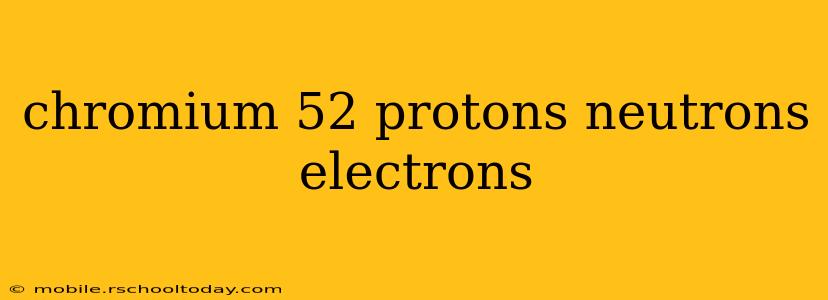Chromium, a lustrous, hard, and brittle transition metal, finds extensive use in various alloys and industrial applications. Understanding its atomic structure, particularly in the Chromium-52 isotope, is crucial for comprehending its chemical and physical properties. This article delves into the specifics of Chromium-52, clarifying its proton, neutron, and electron counts.
Understanding Atomic Structure
Before we dive into the specifics of Chromium-52, let's briefly review the fundamental components of an atom:
- Protons: Positively charged particles found in the atom's nucleus. The number of protons defines the element; all chromium atoms have 24 protons.
- Neutrons: Neutrally charged particles residing in the atom's nucleus alongside protons. The number of neutrons can vary within an element, leading to different isotopes.
- Electrons: Negatively charged particles orbiting the nucleus in electron shells. In a neutral atom, the number of electrons equals the number of protons.
Chromium-52: The Breakdown
Chromium-52 (⁵²Cr) is the most abundant isotope of chromium, making up approximately 83.8% of naturally occurring chromium. The number 52 represents the total number of protons and neutrons in the atom's nucleus (its mass number).
- Protons: As with all chromium atoms, Chromium-52 contains 24 protons. This is its atomic number and what defines it as chromium.
- Neutrons: To find the number of neutrons, subtract the number of protons (atomic number) from the mass number: 52 - 24 = 28 neutrons.
- Electrons: In a neutral Chromium-52 atom, the number of electrons equals the number of protons, resulting in 24 electrons.
Isotopes and their Significance
Isotopes are atoms of the same element with the same number of protons but differing numbers of neutrons. While the number of protons dictates the chemical behavior of an element, the number of neutrons affects its physical properties, such as its mass and stability. Some isotopes are radioactive, while others, like Chromium-52, are stable. The differing isotopic abundances influence the average atomic mass of an element reported on the periodic table.
Chromium Isotopes: A Quick Overview
Chromium has several isotopes, but Chromium-52 is by far the most prevalent. Other significant isotopes include Chromium-50 and Chromium-53, both of which are also stable, although less abundant than Chromium-52.
Conclusion
In summary, Chromium-52, the most abundant chromium isotope, possesses 24 protons, 28 neutrons, and 24 electrons in a neutral state. Understanding the atomic structure of Chromium-52, and isotopes in general, is essential for appreciating the element's properties and its applications across various scientific and industrial fields. This knowledge forms a foundation for further exploration into the intricacies of nuclear chemistry and materials science.
